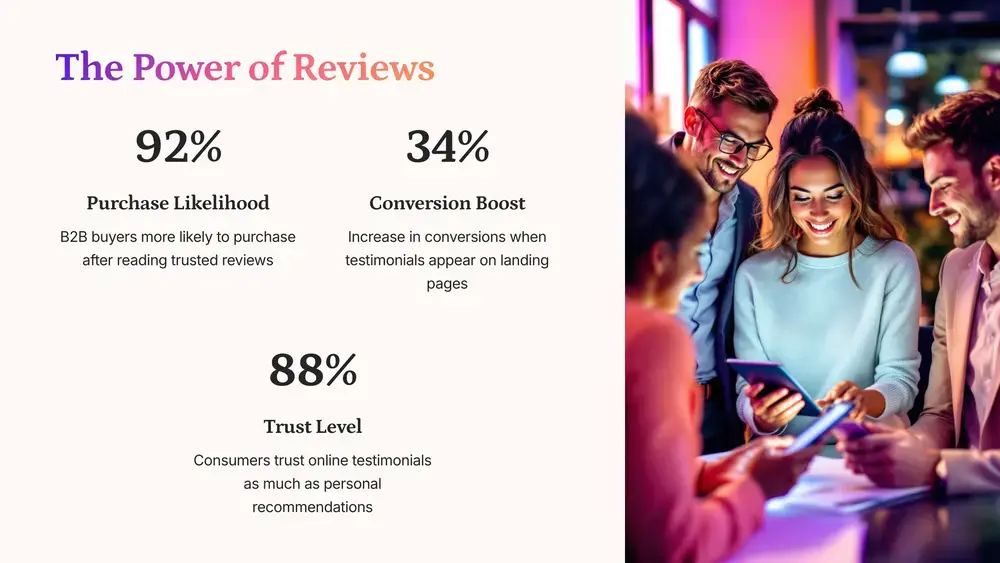Value Proposition Problems: Why Your SaaS Website Isn't Generating Leads

Share this post
Executive Summary
This article examines why unclear value propositions are the primary reason SaaS websites fail to generate leads. Research shows visitors make stay-or-leave decisions within 10 seconds, making a clear, compelling value proposition essential for conversion. Common pitfalls include visitor confusion, failure to differentiate from competitors, misalignment with target audiences, and describing features without connecting them to benefits. The article provides actionable strategies to transform weak value propositions, including defining ideal customer profiles, focusing on measurable outcomes rather than features, crafting concise messaging, optimizing hero sections, and implementing continuous testing. By addressing these issues, SaaS companies can significantly improve their website's ability to convert visitors into qualified leads.
Why Your SaaS Website Is Failing to Convert Visitors Into Qualified Leads
Introduction
Your SaaS website gets traffic, but visitors bounce without converting to leads. The most common culprit? A weak value proposition that fails to instantly communicate why your solution matters.
In my previous article Why Most SaaS Websites Fail to Convert Visitors Into Leads, I identified several critical conversion barriers affecting SaaS websites. This article explores one of the most impactful factors in depth: the unclear value proposition. Your SaaS website gets traffic, but visitors bounce without converting to leads. The most common culprit? A weak value proposition that fails to instantly communicate why your solution matters.
What Makes a Strong SaaS Value Proposition?
A value proposition isn't just a catchy tagline. It's the fundamental promise you make to potential customers—articulating what problem you solve, how you solve it, and why your approach is uniquely beneficial.
An effective SaaS value proposition must:
- Immediately communicate the primary benefit
- Specify who the solution is for
- Differentiate from competitors
- Substantiate claims with evidence
- Connect features to tangible outcomes
The 10-Second Rule: Why Clarity Must Be Instant
Research shows websites have approximately 10 seconds to communicate their value before losing visitor attention. This narrow window makes clarity non-negotiable.
When SaaS homepages lead with vague statements like "Transforming Business Operations" or "Next-Generation Customer Experience," they waste this critical opportunity. Instead of explaining specific benefits, these generic phrases create confusion that drives potential leads away.
How Value Proposition Ambiguity Sabotages Lead Generation
1. Visitor Confusion & Cognitive Overload
When visitors can't quickly understand what your product does and why it matters, they experience cognitive overload. Rather than working to decipher your offering, most will simply leave.
This confusion often manifests as:
- Difficulty explaining what the product actually does
- Uncertainty about whether the solution addresses their needs
- Inability to determine if the product is worth investigating further

2. Failure to Differentiate in a Crowded Market
The SaaS landscape is increasingly competitive. Without clear differentiation in your value proposition, visitors have no compelling reason to choose your solution over alternatives.
Generic messaging like "Streamline Your Workflow" could apply to hundreds of different products. Without specificity, you blend into the background noise of similar-sounding options.
3. Misalignment with Target Audience
Many ineffective value propositions stem from inadequate understanding of the Ideal Customer Profile (ICP). Without this foundation, messaging can't be tailored to address the specific pain points, language, and priorities of your target audience.
The fatal error of trying to position a product for "everyone" results in messaging that resonates with no one.
4. The "So What?" Test Failure
A common pitfall is describing features without translating them into benefits. Stating your platform "Incorporates AI algorithms" fails the essential "so what?" test—it doesn't explain the tangible outcome for the user.
Contrast this with "Reduces data analysis time by 75% with AI," which connects the feature to a specific, measurable benefit.
5. Hero Section Weaknesses
The hero section—typically the first visible area of your homepage—is where your value proposition must shine. When this critical first impression fails through weak headlines, unclear subheadlines, or disconnected visuals, visitors rarely scroll further, halting the lead generation process before it begins.
The Deeper Problem: Strategic Uncertainties
A weak external value proposition often reflects internal strategic weaknesses. Companies struggling to articulate their value clearly on their website frequently have not:
- Defined their ICP with sufficient precision
- Validated their product-market fit thoroughly
- Agreed internally on their core differentiators
- Mapped features to specific customer outcomes
This internal ambiguity inevitably translates to unclear external messaging that fails to convert website visitors into leads.
Real-World Examples: Value Proposition Failures vs. Successes
Failure Example:
"Our integrated platform leverages cutting-edge technology to optimize your business processes."
This statement fails because it:
- Uses vague jargon ("integrated platform," "cutting-edge")
- Doesn't specify who it's for
- Makes no concrete promise
- Provides no evidence
- Offers no differentiation
Success Example:
"Help desk teams resolve tickets 35% faster with our AI-powered categorization that automatically routes issues to the right specialist."
This succeeds because it:
- Names the specific audience (help desk teams)
- Promises a quantifiable benefit (35% faster resolution)
- Identifies the mechanism (AI categorization and routing)
- Implies uniqueness through specificity
- Connects feature to outcome
Transforming Your Value Proposition: Actionable Strategies
1. Define Your ICP and Buyer Personas
Before attempting to craft a compelling value proposition, invest time in deeply understanding:
- Who specifically benefits most from your solution
- What particular problems they're trying to solve
- How they evaluate potential solutions
- What success looks like from their perspective
- The language they use to describe their challenges
This foundation is essential for messaging that resonates with your ideal leads.
2. Focus on Benefits & Outcomes
Translate every feature into a clear user benefit by:
- Identifying the end result the feature enables
- Quantifying the impact whenever possible
- Framing the user as the hero achieving success
- Showcasing the contrast between the old way and your solution
- Using specific examples that bring abstract concepts to life
3. Craft Clear & Concise Messaging
Create a powerful headline and supporting elements that:
- Use simple, direct language understandable to your target audience
- Eliminate industry jargon and buzzwords
- Make a specific, verifiable claim
- Focus on a single primary benefit (with secondary benefits as support)
- Match the language your customers use
4. Optimize the Hero Section
Ensure all elements of your hero section work together cohesively:
- Headline captures primary value in 8-10 words
- Subheadline expands on how you deliver this value
- Supporting visuals reinforce rather than distract from the message
- Primary CTA clearly indicates the logical next step
- Social proof elements substantiate your claims
5. Test and Refine Continuously
Value proposition optimization is never "done." Implement:
- A/B testing of different headline variations
- User testing to gather feedback on clarity and impact
- Analysis of engagement metrics for different messaging approaches
- Continuous refinement based on conversion data
Measuring Value Proposition Effectiveness
Track these metrics to gauge improvement:
- Bounce rate on your homepage
- Time on page for first-time visitors
- Click-through rate on primary CTAs
- Conversion rate from visitor to lead
- Qualitative feedback from sales calls about prospect understanding
Conclusion: From Confusion to Conversion
A clear, compelling value proposition is the foundation of effective SaaS lead generation. By addressing the common pitfalls outlined above and implementing the recommended strategies, you can transform your website from a source of visitor confusion into a lead generation engine.
Remember that the goal isn't just to describe what your product does, but to articulate how it meaningfully improves your customers' work and lives. When visitors immediately understand this value, they're significantly more likely to convert into qualified leads.




